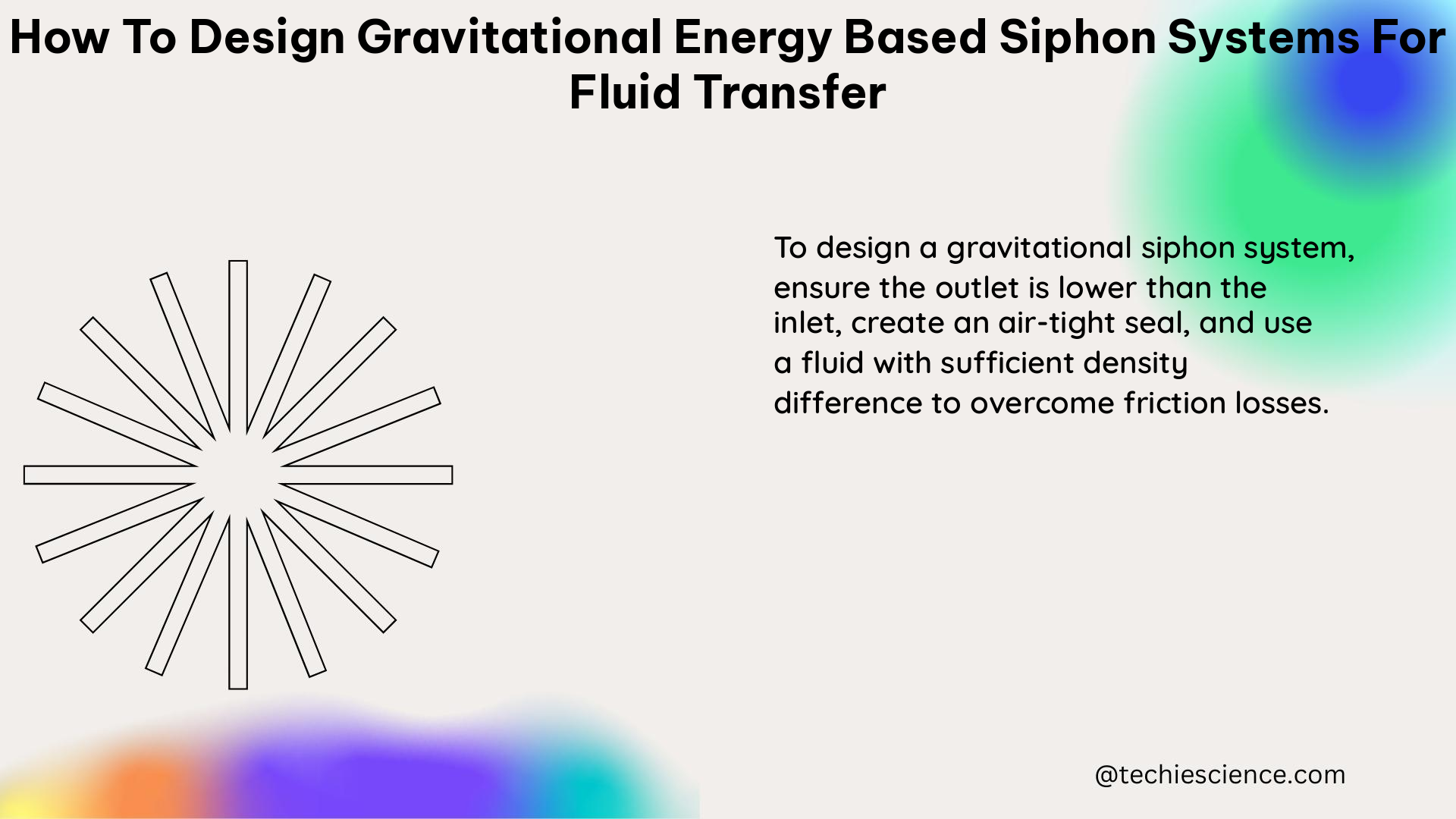Designing a gravitational energy-based siphon system for fluid transfer involves a deep understanding of the underlying physics principles and the application of mathematical formulas to calculate the critical parameters. This comprehensive guide will provide you with a step-by-step approach to designing an efficient and effective siphon system that utilizes the power of gravity for fluid transfer.
Fundamental Principles of Siphon Operation
A siphon is a simple device that uses the principle of atmospheric pressure and the difference in height to transfer fluid from a higher level to a lower level. The siphon consists of a tube or pipe that is open at both ends and is angled downward from the higher level to the lower level.
The pressure difference between the two ends of the siphon is the driving force behind the fluid flow. At the surface of the fluid in the upper reservoir, the pressure is equal to the atmospheric pressure. However, at the drain point, the pressure is lower due to the height difference, creating a pressure gradient that causes the fluid to flow through the siphon.
Calculating the Velocity of the Siphon

The velocity of the siphon is a crucial parameter in the design process, as it determines the flow rate and the efficiency of the system. The velocity of the siphon can be calculated using the following formula:
vC = √(2 × g × hC)
Where:
– vC is the velocity of the siphon (m/s)
– g is the acceleration due to gravity (9.81 m/s²)
– hC is the height difference between the surface of the upper reservoir and the drain point (m)
This formula assumes that the fluid is flowing through the siphon without any friction losses or other resistance factors.
Calculating the Maximum Velocity of the Siphon
To ensure the siphon operates efficiently and without the risk of cavitation or other issues, it is essential to calculate the maximum velocity of the siphon. The maximum velocity is limited by the pressure difference between the atmospheric pressure and the pressure at the intermediate high point of the siphon. The formula for calculating the maximum velocity is:
vmax = √(2 × (Patmospheric / ρ - g × hB))
Where:
– vmax is the maximum velocity of the siphon (m/s)
– Patmospheric is the atmospheric pressure (Pa)
– ρ is the density of the fluid (kg/m³)
– g is the acceleration due to gravity (9.81 m/s²)
– hB is the height of the intermediate high point (m)
The maximum velocity should be greater than the calculated velocity of the siphon to ensure efficient operation.
Selecting the Pipe Size and Material
The pipe size and material are critical factors in the design of a siphon system, as they directly impact the flow rate and the overall efficiency of the system. The pipe size should be selected based on the required flow rate, the pipe friction loss tables, and the elevation head.
Different pipe materials, such as PVC, HDPE, or FRP, will have different friction losses, which will affect the flow rate. It is essential to consider the pipe material and size to optimize the siphon system’s performance.
Addressing Air Entrainment and Start-up Challenges
One of the common challenges in siphon systems is the issue of air entrainment, which can disrupt the fluid flow and cause the siphon to fail. To address this, a vacuum pump may be required to suck air out of the system during start-up, especially if the height difference is significant.
The vacuum pump creates a partial vacuum that allows the pressure on the entrance point of the higher container to push the fluid up the leg on that side, initiating the siphon action.
Example Calculation
Let’s consider an example of designing a siphon system to transfer water from a reservoir at a height of 10 meters to a drain point at a height of 2 meters. The required flow rate is 3,900 m³/hr, and the pipe material is FRP.
-
Calculating the velocity of the siphon:
vC = √(2 × 9.81 m/s² × 8 m) = 12.5 m/s -
Calculating the maximum velocity of the siphon:
vmax = √(2 × (101,325 Pa / 1,000 kg/m³ - 9.81 m/s² × 2 m)) = 11.2 m/s -
Selecting the pipe size:
Based on the flow rate and the pipe friction loss tables, a pipe size of 200 mm is selected. -
Addressing air entrainment and start-up challenges:
Since the height difference is significant (8 meters), a vacuum pump may be required to suck air out of the system during start-up to initiate the siphon action.
By following these steps and considering the critical factors, you can design an efficient and effective siphon system that utilizes gravitational energy for fluid transfer.
Reference:

The lambdageeks.com Core SME Team is a group of experienced subject matter experts from diverse scientific and technical fields including Physics, Chemistry, Technology,Electronics & Electrical Engineering, Automotive, Mechanical Engineering. Our team collaborates to create high-quality, well-researched articles on a wide range of science and technology topics for the lambdageeks.com website.
All Our Senior SME are having more than 7 Years of experience in the respective fields . They are either Working Industry Professionals or assocaited With different Universities. Refer Our Authors Page to get to know About our Core SMEs.